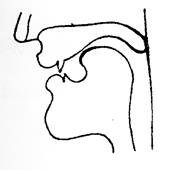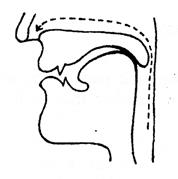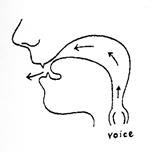The Diagrams on Consonant Sounds
[p]and [b]
Study the diagram below and read through the notice carefully.

|
NOTICE:
1. The lips are closed firmly and the soft palate is raised so that the breath cannot get out of either the nose or the mouth but is trapped for a short time.
2. When the lips are opened suddenly the breath rushes out with a slight explosion or popping noise.
3. Before the lips are opened, the rest of the mouth takes up the position for the following sound, a vowel position if a vowel follows, as in pool, or a consonant position if a consonant follows, as in play.
[t]and[d]
Study the diagram below and read through the notice carefully.

|
NOTICE:
1. The tip of the tongue (not the blade) is firmly against the middle of the alveolar ridge, not too near the teeth and not near the hard palate.
2. The soft palate is raised, so the breath cannot escape through either the nose or the mouth, but is trapped for a short time.
3. The sides of the tongue are firmly against the sides of the palate, so that the breath cannot pass over the sides of the tongue.
4. When the tongue-tip is lowered suddenly from the teeth ridge the breath rushes out with a slight explosion or popping noise.
[k]and[g]
Study the diagram below and read through the notice carefully.

|
NOTICE:
1. The back of the tongue is in firm contact with the soft palate, and the soft palate is raised, so that the breath is trapped for a short time.
2. When the tongue is lowered suddenly from the soft palate, the breath rushes out of the mouth with a slight explosion or popping noise.
[f]and[v]
Study the diagram below and read through the notice carefully.

|
NOTICE:
1. The soft palate is raised so that no air goes through the nose and it is all forced through the mouth.
2. The bottom lip is very close to the upper front teeth: this forms the narrowing and when air is pushed through this narrowing it causes slight friction.
3. The tongue is not directly concerned in making these sounds, but it does not lie idle; it takes up the position necessary for the following sound, so in [fi:] it will be in the [i:] position whilst [f] is being pronounced, and in [fri:] it will be in the [r] position, and so on. 
[s]and [z]
Study the diagram below and read through the notice carefully.

|
NOTICE:
1. The soft palate is raised so that all the breath is forced to go through the mouth.
2. The tip and blade of the tongue are very close to the alveolar ridge. There is a very considerable narrowing at this point, not near the teeth and not near the hard palate.
3. The teeth are very close together.
4. The friction for these sounds, especially for [s], is much greater than for [f, v, q] and [D].
[q]and [D]
Study the diagram below and read through the notice carefully.

|
NOTICE:
1. The soft palate is raised so that all the breath is forced to go through the mouth.
2. The tip of the tongue is close to the upper front teeth: this is the narrowing where the friction is made.
3. The noise made by the friction for [q] and [D] is not very great, much less than for [s] and [z]
[S] and[Z]
Study the diagram below and read through the notice carefully.

|
NOTICE:
1. The soft palate is raised so that all the breath is forced to go through the mouth.
2. There is a narrowing between the tip of the tongue and the back of the alveolar ridge.
3. The front of the tongue is higher than for [s] and [z].
4. The lips are very slightly rounded.
[tS]and[dZ]
Study the diagram below and read through the notice carefully.

|
NOTICE:
1. The tongue-tip touches the back part of the alveolar ridge, and the soft palate is raised so that the breath is trapped for a short time.
2. The rest of the tongue is in the [S, Z] position.
3. The tongue-tip moves away from the alveolar ridge a little way (see the dotted lines), and the whole tongue is then in the [S, Z] position, so that a short period of this friction is heard. The friction of [tS] and [dZ] is not so long as for [S] and [Z] alone.
[h]
Study the diagram below and read through the notice carefully.

|
NOTICE:
1. Push a lot of air out very quickly.
2. Do not touch the roof of your mouth with your tongue.
[m]and [n]
Study the diagram below and read through the notice carefully.

|
NOTICE:
1. The soft palate is lowered for both [m] and [n].
2. For [m] the mouth is blocked by closing the two lips, for [n] by pressing the tip of the tongue against the alveolar ridge, and the sides of the tongue against the sides of the palate.
3. Both sounds are voiced in English, as they are in other languages, and the voiced air passes out through the nose.
[N]
Study the diagram below and read through the notice carefully.

|
NOTICE:
1. The soft palate is lowered and all the air passes out through the nose.
2. The mouth is blocked by the back of the tongue pressed against the soft palate.
3. The sound is voiced.
[l]
Study the diagram below and read through the notice carefully.

|
NOTICE:
1. The soft palate is raised.
2. The tongue-tip (and the sides of the tongue-blade which cannot be seen in the diagram) are in firm contact with the alveolar ridge, obstructing the centre of the mouth.
3. The sides of the remainder of the tongue are not in contact with the sides of the palate, so air can pass between the sides of the tongue and the palate, round the central obstruction formed by the tip and blade of the tongue and so out of the mouth.
4. The sound is voiced and there is no friction (except when it is immediately after [p] or [k].
[r]
Study the diagram below and read through the notice carefully.

|
NOTICE:
1. The tongue has a curved shape with the tip pointing towards the hard palate at the back of the alveolar ridge, the front low and the back rather high.
2. The tongue-tip is not close enough to the palate to cause friction.
3. The lips are rather rounded, especially when [r] is at the beginning of words.
4. The soft palate is raised; and voiced air flows quietly between the tongue-tip and palate with no friction.
[w]
Study the diagram below and read through the notice carefully.

|
NOTICE:
1. First practise [u:]. Make your lips round and hard for [w].
2. [w] is a short sound.
[ j ]
Study the diagram below and read through the notice carefully.

|
NOTICE:
1. First practise [i:].
2. Very quickly move your tongue to make the next sound.
3. Do not touch the roof of your mouth with your tongue.
Дата добавления: 2016-08-07; просмотров: 1227;
